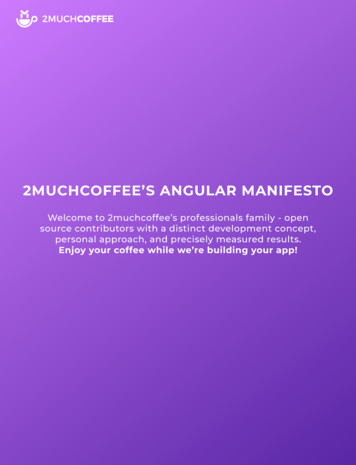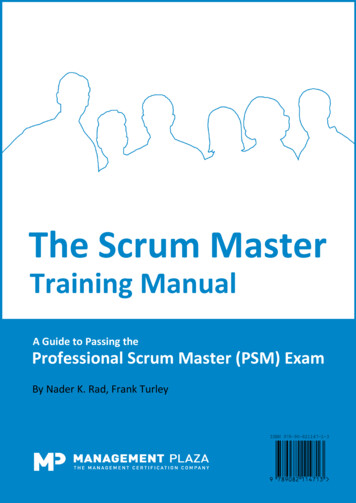
Transcription
2MUCHCOFFEE’S ANGULAR MANIFESTOWelcome to 2muchcoffee’s professionals family - opensource contributors with a distinct development concept,personal approach, and precisely measured results.Enjoy your coffee while we’re building your app!
CONTENTS1. Fundamental Architectural points32. Basic Angular-scope points53. Main RxJS points84. Code quality points95. Open source NGX-restangular106. Contacts11We are honored to present an Angular Manifesto based on Angular’steam recommendations, commonly used best practices, and expandedwith our personal long-term experience and technical expertize.Enjoyyour coffee while we’re building your app!
FUNDAMENTALARCHITECTURAL POINTS1. Use the Angular CLI for initializing, developing, building, scaffoldingand maintaining Angular applications;2. File structure - use commonly used practices declared by anAngular’s team and follow the LIFT principle;3 Use the Core, Shared and Feature modules for better codemanagement and architecture:3.1. The Core module:Should include only singletons: Services, Models, Interceptors,Resolvers, application-wide components that are being used onlyonce in the AppComponent template;Prevent re-import of the Core module.3.2. The Shared module:Should contain commonly used/re-used throughout the appComponents, Directives, Pipes;Should contain third-party libraries modules that are used atleast in 50% of modules across the app;Should not contain third-party libraries modules that areheavyweight unless it’s used in most of the modules throughoutthe app;In case the main eager-loaded module, e.g. “HomeModule”doesn’t need most of the Shared module imports, then youshould import to it only specific modules/components etc.3
FUNDAMENTAL ARCHITECTURAL POINTS4. Implement the lazy-load workflow where it’s possible.5. Services, Components, and functions inside them should bereadable, not bulky and primary follow the single-responsibilityprinciple. Consider:Limiting files to 400 lines of code;Limiting functions to no more than 75 lines.6. Extract templates and styles into a separate file.7. Use libraries that are written specifically for Angular, otherwisecreate Angular wrappers for them.4
BASIC ANGULAR-SCOPE POINTS1. A Component should conform to the following structure:static properties;@Input properties;properties(public first, then private);accessors(public first, then private);constructor method implementation;lifecycle hook methods implementations;methods(public first, then private).2. Appropriate naming:The file names and the element selectors of Components shouldbe written in a dashed-case(kebab-case);Always give the filename the conventional suffix (suchas .component.ts, .directive.ts, .module.ts, .pipe.ts, .service.tsor .spec.ts) for a file of that type;Suffix a Module/Component/Directive/Service class name withModule/Component/Directive/Service relatively, e.g.UsersComponent, DataService;Use consistent names for all Services and Pipes named after theirfeature;5
BASIC ANGULAR-SCOPE POINTSUse the lower camel case for naming variables, including “const”,and methods;Use the lower camel case and a custom prefix for naming theselectors of Directives;Use the upper camel case for naming the Classes and Interfaces;Consider using a class instead of an Interface, otherwise, considernaming an interface without an I prefix;Avoid prefixing private properties and methods with anunderscore;In case an Accessor or a variable contains a stream, then its nameshould include the “ ” sign in the end;In case a variable contains a boolean value - the name of such avariable should start f rom the “is” preposition, e.g. “isAdmin”;Don’t prefix the output properties with, e.g. the suffix “on”;The properties and functions names should be explicit anddirectly conform to its functionality;6
BASIC ANGULAR-SCOPE POINTS3. Keep the presentation logic in the Component class, and not in theTemplate.4. Limit logic in a Component to only that required for the View delegate complex Component’s logic to a Service.5. Use Services for any server data processing, e.g. API requests,Actions dispatching etc.6. The direct references to global objects, e.g. window, document arenot allowed for permanent usages. To reference the window objectyou have to create a specific service that can be injected throughoutthe app. For example, in case you need to use the Document object,Angular provides it in the form of constant f rom @angular/common;7. Preferably use pure pipes with only pure functions. In case you needto call a function in a template - make it memoized through a pipe.7
MAIN RXJS POINTS1. Use async pipe preferably.2. Never subscribe in another subscribe - use appropriate RxJSoperators instead, i.e the “switchMap” operator.3. Don’t subscribe in methods - use for subscriptions Angular lifecyclehooks that are called only once after calling the constructor.4. Avoid subscriptions in a Service if it’s not a singleton.5. Always unsubscribe f rom a stream in the ngOnDestroy lifecyclehook in case it’s not possible to use the async pipe.6. Preferably don’t combinate Promises or the RxJS operator“toPromise” with Observables.7. Never use the setTimeout - use appropriate RxJS operators.8. Don’t use RxJS timeline operators if you just need to run throughthe ngZone.9. Use RxJS Subjects for temporary data saving and handling events;8
CODE QUALITY POINTS1. tslint.json - create/use a distinct, unified and consistent coding,naming, and whitespace conventions.2. Use Typescript typing power - provide type definitions for alldeclarations across the app.3. Consider using the “ordered-imports” tslint rule - files imports:3.1. Should be alphabetized;3.2. Should be structured according to a commonly used styleguide, described in TSLint rules as a “groups” option:Angular imports;Third party libraries imports;Parent level application imports;Current level application imports;Children level application imports.3.3. Each type of imports should be separated with an empty line.4. Use the @Input and @Output() class decorators instead of theinputs and outputs properties of the @Directive and @Componentmetadata. Consider placing decorators on the same line as theproperty it decorates.5. Use the @HostListener and @HostBinding instead of the hostproperty.6. Use current and supported libraries only.9
OPEN SOURCE NGXRESTANGULARNgx-restangular is an Angular 2 service that simplifies commonGET, POST, DELETE, and PUT requests with a minimum of a clientcode. Ngx-restangular is responsible for communication betweenAPI and complex frontend web apps.FEATURES1. Self-linking elements support;2. Supports both - Promises and Observables;3. Send a request f rom/within an object - don’t create a new object foreach request;4. Supports nested RESTful resources;5. Use meaningful names instead of URLs;6. Provides an ability to create your own HTTP methods;7. Send requests easily using different settings;GITHUB10
YOU’RE WELCOME TOCONTACT OUR CEODMITRIY UCHCOFFEEsales@2muchcoffee.com2muchcoffee.com11
2. Basic Angular-scope points 3. Main RxJS points 4. Code quality points 5. Open source NGX-restangular 6. Contacts We are honored to present an Angular Manifesto based on Angular's team recommendations, commonly used best practices, and expanded with our personal long-term experience and technical expertize.Enjoy










